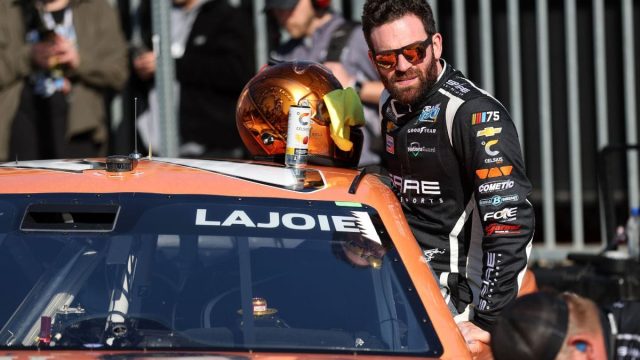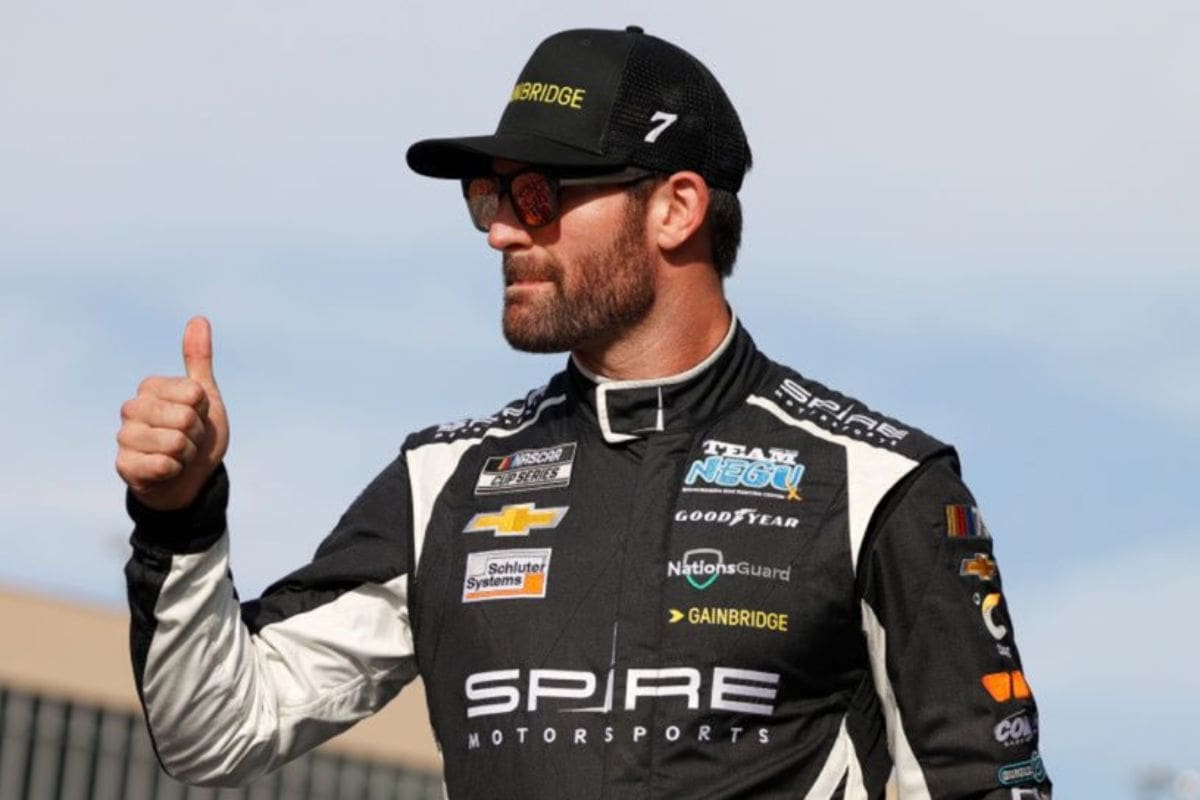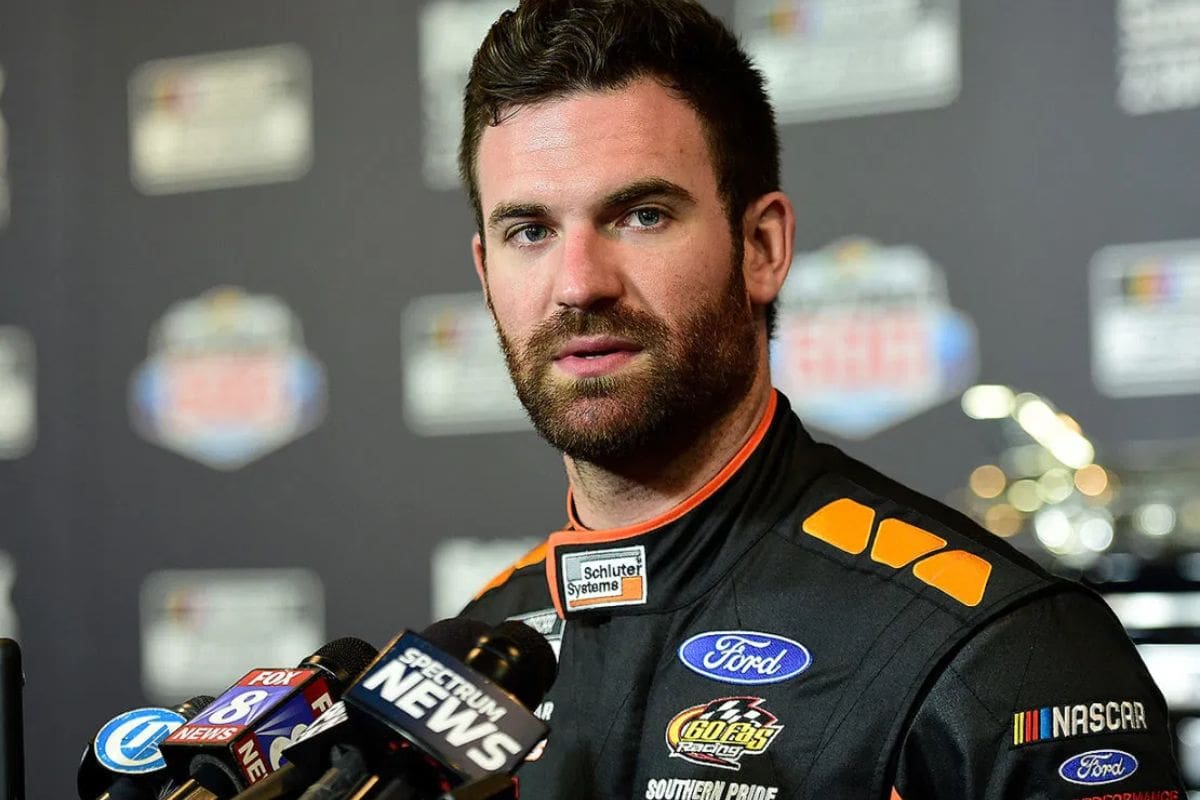Corey LaJoie’s Watkins Glen Blunder: Corey LaJoie‘s recent miscalculation at Watkins Glen has not only jeopardized his own racing ambitions but has also inflicted considerable damage on the playoff hopes of fellow competitors like Ryan Blaney and Denny Hamlin. The incident, characterized by a reckless overdrive influenced by newly implemented rumble strips, has ignited a firestorm of criticism aimed at LaJoie, raising questions about driver accountability in high-stakes scenarios. As the dust settles on this controversial event, the implications for LaJoie and the broader playoff landscape remain uncertain, prompting a closer examination of the potential fallout.
Key Highlights
- Corey LaJoie’s misjudged braking at Watkins Glen caused a multi-car pile-up, significantly damaging his vehicle and altering playoff standings.
- The incident resulted in a DNF for Ryan Blaney and affected Denny Hamlin, jeopardizing their championship aspirations.
- LaJoie acknowledged his error, emphasizing accountability and the need to learn from the disruptive experience.
- Fan outrage and media scrutiny ensued, highlighting frustrations with LaJoie’s decision-making during critical race moments.
- LaJoie’s playoff points deficit deepened post-incident, raising concerns about his future in the series and team dynamics.
Corey LaJoie’s 2024 Struggles and Recent Incident
Corey LaJoie’s 2024 season in the Cup Series has been marked by escalating challenges, culminating in a remarkable misstep at Watkins Glen. His tenure with Spire Motorsports has come to an abrupt end, leaving him in a precarious position as he seeks new opportunities within a highly competitive field. This environment demands not only skill but also a certain level of consistency and reliability, qualities that LaJoie has struggled to exhibit this season.
The demands of auditioning for a new team can be overwhelming, and it appears this strain has manifested in a series of unfortunate incidents on the track. Remarkably, LaJoie’s racing misjudgments have resulted in collisions that have impacted not only his own performance but also that of his competitors.
The incident involving Kyle Busch at Watkins Glen further highlights this troubling trend. Their history, stemming from an earlier encounter at Pocono, has created a narrative of frustration, especially for Busch, who has found himself repeatedly entangled in LaJoie’s blunders.
While LaJoie has taken accountability for his recent actions, the pattern of mistakes raises questions about his ability to maintain composure under strain. As the season progresses, the repercussions of these missteps could prove detrimental to his career aspirations, particularly in a sport where every race can appreciably influence a driver’s path.
LaJoie’s 2024 season has become a study in the consequences of high-stakes racing and the critical importance of precision and focus in the Cup Series.
The Watkins Glen Incident
The Watkins Glen incident exemplifies the precarious nature of racing at one of NASCAR’s most challenging tracks. The bus stop section, notorious for its tight turns and unforgiving curbing, posed a notable test for drivers, particularly in the high-stakes environment of a race. Corey LaJoie found himself grappling with the complexities of this segment, relying on the guidance of the #45 car to navigate the intricacies of the course.
As LaJoie approached the corner, he misjudged his braking point, a critical error worsened by the new rumble strips that replaced the excess curbing. This miscalculation resulted in an overdrive that sent him careening into the rear of the #8 Chevrolet, causing a multi-car pile-up on the very initial lap.
The chaos that ensued not only ended LaJoie’s race prematurely but also considerably impacted several competitors, including Busch, who was left bewildered by the sudden turn of events. Busch’s frustration was visible as he sought to identify the source of the incident, ultimately leading to a remark about the “biggest idiot” on the track.
This moment covered the tension and unpredictability of NASCAR racing, where a single mistake can have far-reaching consequences. LaJoie’s blunder at Watkins Glen serves as a striking reminder of the razor-thin margins that define success in this sport, highlighting the critical need for precision and awareness in high-pressure situations.
LaJoie’s Accountability and Response
Acknowledging responsibility is a crucial aspect of professional racing, and LaJoie’s response to the Watkins Glen incident presents this principle. In clear contrast to his previous Pocono mishap, LaJoie openly admitted his shortcomings and expressed regret over the incident that disrupted not only his race but potentially the playoff aspirations of his competitors.
“So I wanted to give the 8 room there, crowded and I ended up coming into his bumper. There’s no excuse for that. My only intention the first lap was to get a single lap and not ruin anybody’s day, and that’s the exact opposite of what happened,” -(corey)
His remarks on the Stacking Pennies podcast highlighted the weight of his actions, as he articulated the desire to avoid interference with others while maneuvering the track.
Key elements of LaJoie’s response include:
- Acknowledgment of the error in judgment
- Recognition of the impact on fellow drivers
- An understanding of the precarious nature of racing dynamics
- Anticipation of potential repercussions from competitors
- A commitment to learning from the experience
This introspective approach not only demonstrates LaJoie’s character but also emphasizes the importance of accountability in a high-stakes environment.
“We haven’t spoken a word; we have been side by side for weeks. There’s a magnet for the 7 and the 8 car, unfortunately, and he’s had the short end of the stick. So I’m just going to wait on payback which is probably due my way,”-(corey)
As he noted about his relationship with the RCR driver, the tension is palpable, yet his willingness to accept blame mitigates some of the animosity that could arise from such a situation.
LaJoie’s forthright reflection serves as a reminder that in racing, the margin for error is razor-thin, and accountability is paramount for both personal growth and professional integrity.
Impact on Other Playoff Drivers
LaJoie’s incident at Watkins Glen resonated beyond his own race, considerably affecting the playoff landscape for several competitors. The ramifications of his mistake intensified the strain on drivers like Ryan Blaney and Denny Hamlin, who found themselves grappling with notable point losses in the wake of the chaos that ensued.
Blaney, who had been solidly in contention, experienced a devastating DNF due to a minor collision that disrupted his steering. While he managed a commendable bronze-place finish at Atlanta, his inability to score points at Watkins Glen is a glaring reminder of how precarious playoff positioning can be. Each race is an opportunity, yet a single misstep can derail a driver’s championship aspirations.
Denny Hamlin, likewise, faced a tumultuous week, finding himself enveloped in wreckage yet again. His involvement in a multi-car incident, which resulted in a hard impact with the wall, not only damaged his vehicle but also his playoff hopes. Finishing 23rd compounded his struggles, leaving him precariously below the cutline as he heads into Bristol.
The stakes are now higher for Hamlin, who must secure a win to salvage his championship bid.
The ripple effects of LaJoie’s blunder highlight the fragile nature of playoff competition, where one driver’s error can alter the fates of others. As the playoffs progress, it becomes increasingly clear that every lap carries the weight of potential consequences, intensifying the battle as drivers vie for survival.
Overall Consequences and Bristol Outlook
A critical shift in the playoff dynamics has emerged following the chaos at Watkins Glen, setting the stage for a high-stakes showdown at Bristol. The tumultuous race left only two of the 16 playoff drivers in the top 10, resulting in a situation where every point matters more than ever. As drivers prepare for the next battle, the implications of Glen’s outcome loom large, forcing teams to recalibrate their strategies.
Bristol, known for its short track mayhem and tight racing, will certainly heighten the urgency felt by competitors. As they gear up for this crucial race, expect to witness:
- Aggressive overtakes as drivers vie for every position.
- High-stakes pit strategies that could either salvage or sink playoff aspirations.
- Intensified rivalries as personal grudges often flare in the heat of battle.
- Wildcard plays from those outside the top contenders, willing to risk it all for a chance at glory.
- Strategic alliances or unexpected collaborations, as drivers seek to improve their chances in an unpredictable environment.
The ramifications of the Watkins Glen blunder extend beyond LaJoie; they flow through the entire playoff field, intensifying the strain on each driver.
With Bristol on the horizon, the stakes have never been higher, and the atmosphere will be electric. Expect every driver to push their limits, as the quest for playoff survival reaches a fever pitch. In the world of NASCAR, where every lap counts, Bristol could either make or break playoff dreams.
News in Brief: Corey LaJoie’s Watkins Glen Blunder
The Watkins Glen incident presents the significant risks and intense stress within competitive racing, revealing the potential for individual errors to have far-reaching consequences on the broader playoff landscape. The ramifications extend beyond LaJoie, affecting the trajectories of key contenders like Blaney and Hamlin. As discussions surrounding accountability and safety protocols intensify, the implications for LaJoie’s career and the upcoming Bristol race remain uncertain, highlighting the need for critical reflection within the sport.
ALSO READ: Corey LaJoie Calls Out Kyle Busch: “Waiting on Payback” After Watkins Glen Crash




